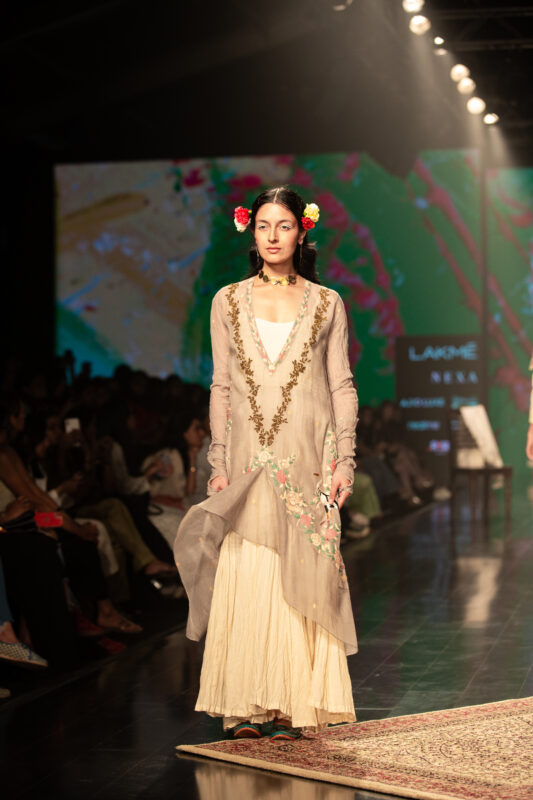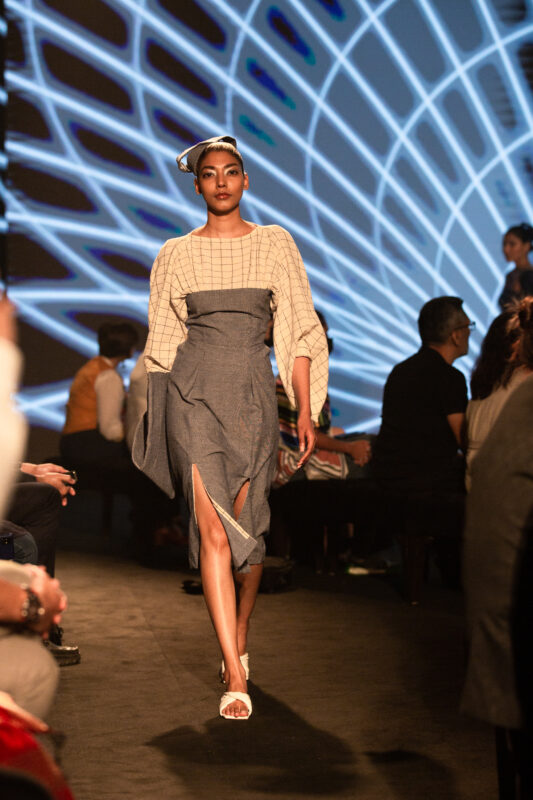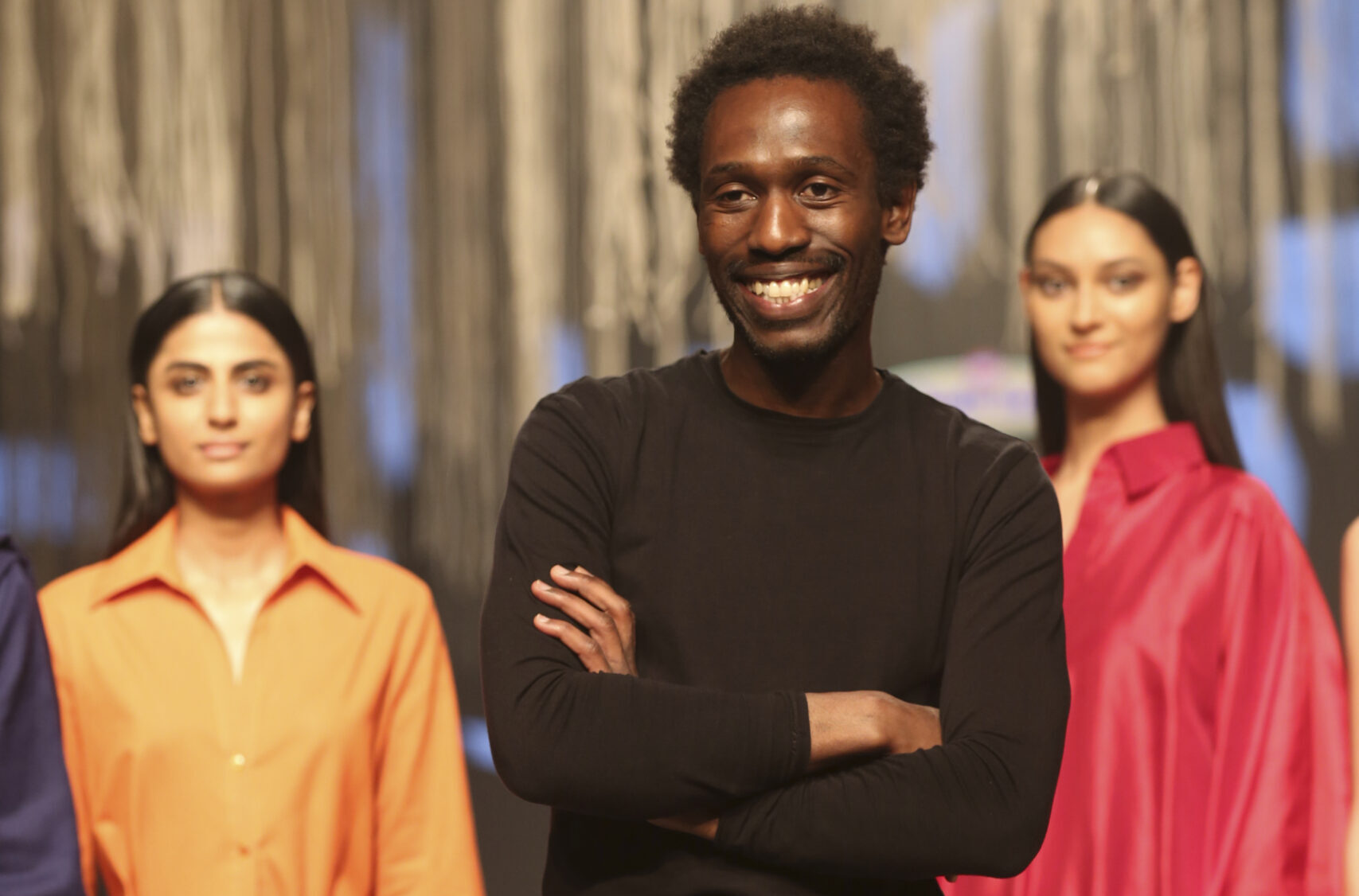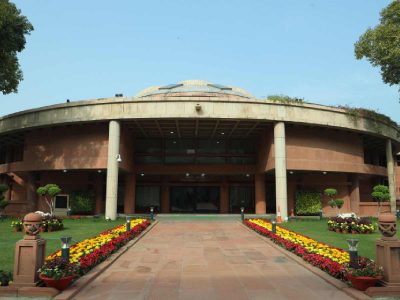There is no denying that we live in a changing world. The heightened awareness, brought on by the pandemic, of the degradation of our planet and its many inhabitants, coupled with the systematic agitation of dedicated climate activists, is beginning to show effect.
A slow yet constant churning of the wheel of sustainability is pushing humanity in the right direction. This was certainly evident in the recently concluded FDCI x Lakme Fashion Week 2022, which took place in its first physical iteration after two years at New Delhi’s Dhyanchand National Stadium.
By focussing on the constant ‘newness’ of trends, the global fashion industry has imperilled the Earth. It is credited with being single-handedly responsible for the accumulation of vast quantities of garment waste, most of which is dumped in mountains of landfills.
In the last few years, particularly, fashion weeks have received tremendous flak for not adhering to the principles of sustainability, prompting the Swedish Fashion Council to take the bold decision of cancelling its country’s twice-a-year Fashion Week.
This year, however, was different. The FDCI x Lakme Fashion Week 2022 saw many firsts – a return to the physical format for people to enjoy a feel of the clothes, the rekindling of broken ties between the Fashion Design Council of India and its original sponsor Lakme, and a strong focus on sustainability in partnership with strategic players like Reliance India through its sustainable textile business R|Elan and the United Nations Environment Program.
There was a lot going on this Fashion Week with 42 shows spread across six action-packed days, and hundreds of fresh looks served on a bevvy of beautiful models and celebrities. However, the showstopper of the season was undoubtedly the focus on sustainability.
A DAY FOR SUSTAINABLE FASHION
In order to prove they weren’t paying mere lip service to being eco-friendly, the organisers of the fashion week set aside an entire day to highlight designers pushing the boundaries of creativity and sustainability. Day 2 of Fashion Week saw an impressive line-up consisting of well-known and new names in sartorial circles, with one thing in common – a love for the environment. The day kicked off with R|Elan presents Circular Design Challenge, where a number of budding designers displayed their cutting-edge design techniques.
This was followed by designers Diksha Khanna and Pratima Pandey – the former’s collection ‘Julley’ was inspired by the barren landscape of Ladakh, and the latter’s titled ‘Paro, a diva reimagined’ took inspiration from Sarat Chandra Chattopadhyay’s iconic leading lady from his novel Devdas.

Next up were labels Antar-Agni and Khanijo, followed by Divyam Mehta, Ka-Sha, Nitin Bal Chauhan, Vaishali S, Payal Pratap, a multi-designer exhibit helmed by Khadi India where French designer Mossi showed his work alongside Abhishek Gupta Benaras, Anavila, Anju Modi, Charu Parashar, and Rina Dhaka.
The finale for the evening was an edgy show by Rajesh Pratap Singh for the label Satya Paul. Each of these designers is known in the industry for a sustainable approach.
A CELEBRATION OF CIRCULARITY
The concept of circularity focuses on zero waste. In particular, the UNEP circularity platform works to provide an understanding of the concept, its scope and how it contributes to promoting sustainable consumption and production patterns.
At the fashion week, this concept played out on the runway through two shows. The first of these was R|Elan presents Circular Design Challenge, whose winner was label Pieux by Pratyush Kumar. The designer had upcycled 50 kg of carpet waste and 100 meters of deadstock fabric in the past few months for his collection.
Sanah Sharma was also accorded the ‘R|Elan Award for Excellence in Circularity’, for her outstanding innovation in circular fashion. Through her proprietary zero-waste cutting technique called Planar Flux, she has reduced the use of water, carbon emissions and fabric waste significantly.

The second show, RISE Worldwide x Fashion for Good present Innovation for Circularity, spotlighted innovations in circular fashion. It showcased the work of three designers – Divyam Mehta’s fabrics were developed from agricultural waste; Ka-Sha’s ‘Manthan’ relied on hand-dyeing using KB cols Sciences’ microbial fermentation technology and non-GMO naturally occurring coloured microbes; Nitin Bal Chauhan’s ‘Countdown’ used Graviky’s AirInk made from carbon collected from vehicles and chimneys for printing and painting fabrics.
ECO-FRIENDLY FABRICS FOR THE WIN
Perhaps, the easiest way to adopt sustainability in a mainstream sense is by switching to eco-friendly fabrics. A large number of designers did exactly that. JJ Valaya partnered with TENCEL Luxe to debut his bridge to luxury collection ‘JJV’.
This fabric is derived from renewable wood sources in a closed-loop process and can easily be blended with other natural fibres like silk, cashmere, and wool. Payal Pratap partnered with Bemberg, a biodegradable and compostable Japanese fibre made from cotton linter obtained from the manufacturing process of cottonseed oil.
Satya Paul worked with the eco-friendly, sustainable fabric R|Elan GreenGold made entirely from used PET bottles through efficient and certified manufacturing practices.
The government of India, through its wing Khadi and Village Industries Commission (KVIC)
too jumped on to promote this worthy cause by organising a showcase of five designers’ interpretations of the versatile fabric Khadi. It was used for modern dresses and skirts by French designer Mossi, elegant eveningwear by Abhishek Gupta Benaras, wearable drapes by Anavila, kitschy resort wear by Rina Dhaka, blingy wedding outfits by Charu Parashar and chic Indian wear by Anju Modi.
UPCYCLING IS THE NEW BUZZWORD
The use of innovative fabrics and techniques may be the way forward, but till they are accepted on a mass scale, upcycling existing clothing is the best way to bridge the gap. Some examples include Rahul Mishra’s use of recycled materials as padding for his voluminous dresses; Varun Bahl’s upcycling of older embroideries in new avatars; and Divyam Mehta’s reliance on agricultural waste through the fabric known as AltMat.
THE BLURRING OF SARTORIAL SEASONS
When it comes to being sustainable in fashion, apparent change is definitely at hand. This is most obvious in the fact that traditional sartorial seasons have been cast aside.
A traditional argument against the fashion industry is its unrelenting focus on seasonal fashion, which in turn encourages people to discard what is no longer ‘trending’ in order to indulge in the ‘new’.
In a huge departure from its previous stand, the FDCI x Lakme Fashion 2022 did not adhere to any season – neither in its branding nor in the brief given to its designers. Hence, an eclectic mix was presented to the audience.
From heavy bridal wear traditional to the Autumn / Winter season in India to trendy resort wear appropriate for Spring and Summer, from casual lounge dresses to sexy sequinned outfits appropriate for balls and galas – one saw it all.
However, since no official announcement was made on this disassociation with traditional fashion seasons, one isn’t sure if sustainability was the reason, or it was merely a way to shine a light on collections that haven’t received their due during the pandemic.
It remains to be seen, therefore, if these measures adopted by FDCI and Lakme will result in lasting change in the quest for sustainability and circularity. Whatever the case may be, the fashion week was certainly a step in the right direction.
(Noor Anand Chawla pens lifestyle articles for various publications and her blog www.nooranandchawla.com. She can be reached at nooranand@gmail.com)
For more stories that cover the ongoings of Delhi NCR, follow us on:
Instagram: https://www.instagram.com/thepatriot_in/
Twitter: https://twitter.com/Patriot_Delhi
Facebook: https://www.facebook.com/Thepatriotnewsindia





